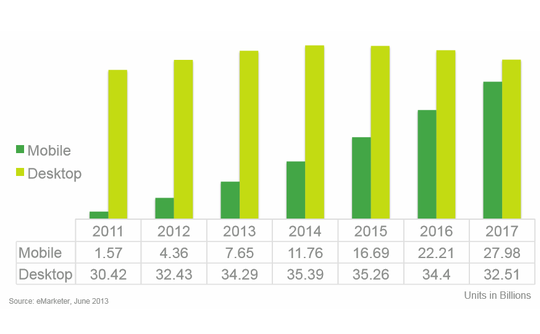Do you feel like you’re running behind in the mobile display advertising race? Are you worried you don’t have the knowledge or capacity to create engaging mobile ad creative? You’re not alone.
Everyone has seen the charts over the last few years showing the incredible growth of mobile display advertising. If it wasn’t quite clear before the graph below from eMarketer shows the exponential growth of the mobile display advertising channel.
Here are some of the main areas to think about as you start to embark on your migration into mobile display advertising. If this seems a little too overwhelming or if you’re not getting the strategic information from your current partner give us a shout.
Mobile Landing Page
Before you should embark on a mobile display advertising campaign you must have a website that is mobile friendly. The term that is thrown around today is “Responsive.” A responsive website is one that will automatically change to provide the best experience for each mobile display device.
If you have a responsive website we recommend creating mobile landing pages for your mobile display advertising just like you would for your Internet marketing. The ad message and creative should be consistent to the page that the visitor lands on after clicking on the mobile display ad. The layout of the page should be optimized for the mobile user since the ads will only be seen on mobile phones.
In-App Ads Versus Mobile Web Advertising
The mobile display advertising spans two different ad spaces, in-app and mobile web. In-app targeting is where we target ads based on the mobile applications description all the way down to being able to select specific mobile applications. Mobile web targeting is where we reach users on mobile websites.
With both types of mobile display advertising we can target the specific audience so there’s no waste of advertising dollars. If your goal is to increase app downloads we can make the landing page the mobile users app-store so they can download the app directly.
Mobile Conversion Tracking
If the budget allows we always recommend the additional cost of conversion tracking. It’s a minor cost and it gives you conversion level tracking information. We can track in-app, mobile web, in-app to mobile web and mobile web to mobile web. The one that’s missing is mobile web to in-app and that’s just around the corner.
We use the conversion tracking information to optimize the mobile display advertising campaigns. We’re able to reconfigure the targeting as well as the creative ads in order to continually improve the cost per conversion.
Mobile Creative Design
In order to get the most penetration we have to create mobile display ads in multiple sizes. For mobile phones we need to create ads in the following sizes: 320×50, 300×250 and 336×280. For tablets we use 728×90 and 468×60 as well.
Most mobile phones don’t support Flash any longer so it’s important to build your mobile display ads using HTML5. Building the ads with HTML5 ensures proper execution and they’re easier to resize for different ad sizes.
Conclusion
Don’t worry about being behind because it’s easy to catch up. You just need to make sure you have the right things in place, use the correct targeting strategy, create the appropriate ad sizes in the appropriate coding language, measure and optimize weekly.
We would be happy to help you out if needed.

